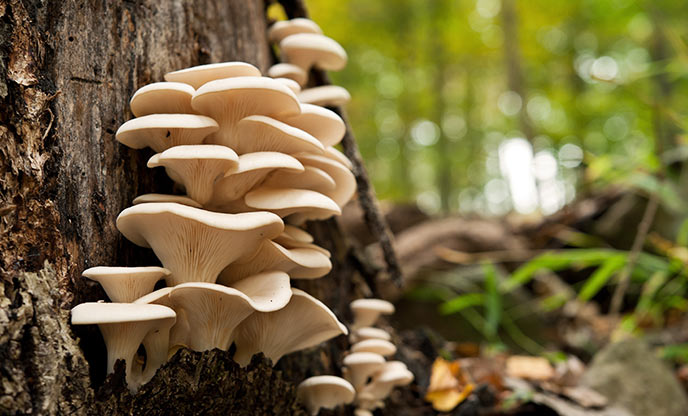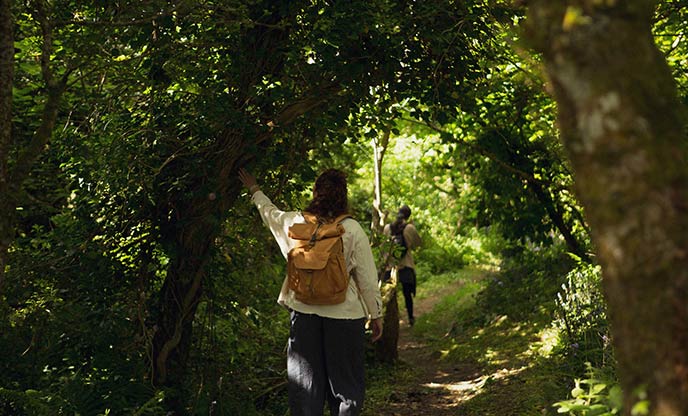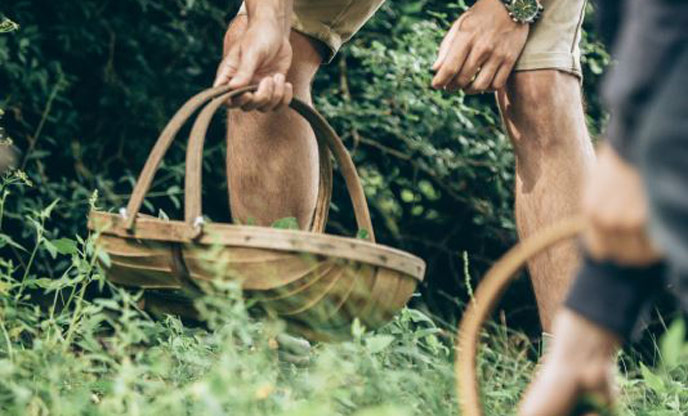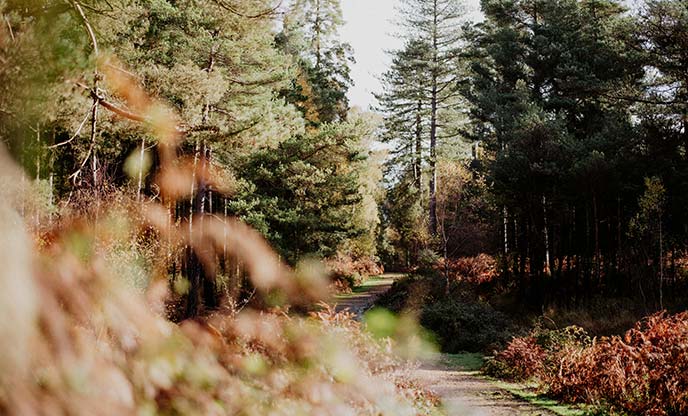Mushroom foraging guide
Penned on the 6th November 2024

There are over 15,000 species of mushroom native to the UK, and whilst you can spot mushrooms throughout the year, in the autumn they truly thrive. With the return of cooler, damper weather, our fields, grassland and woodlands see the arrival of fungi in abundance. It's no surprise therefore that mushroom picking is gaining popularity, particularly when they are such a delicious addition to many meals. In this guide we explore the foraging basics, some popular mushroom species, and where you can find them this autumn.
Just remember, like with plants, not all mushrooms are safe to eat. Some can be poisonous, so it’s essential to start with the basics and always bring along a reliable mushroom identification guide when foraging. If in doubt, don’t touch.
Why forage for mushrooms

Foraging for food is one of the most rewarding pastimes, offering a deep connection to nature and tapping into our ancestral instincts as hunter-gatherers. It often leads us to peaceful, nature-filled places, allowing us to slow down and fully immerse ourselves in the outdoors.
The experience doesn’t end with the foraging itself. Mindfully preparing your wild mushrooms and sharing a delicious, sustainable meal with loved ones creates a sense of fulfilment that's hard to match. This simple routine – of sourcing food directly from the earth, cooking with care, and nourishing those around you – provides both healthy sustenance and a profound connection to the natural world.
Foraging safety
- The number one rule of foraging is: do not eat anything unless you are one hundred percent sure what it is. The UK is home to some potentially fatal plants and fungi species. Here are our top tips for safe foraging:
- Only eat something if you are one hundred percent sure you know what it is
- Only try one new mushroom species at a time, as some people have allergies or intolerances
- Double check your findings when you get home
- Cross-reference between at least two sources of information when identifying mushrooms e.g. two different books or websites
- If you are not one hundred percent certain, find a professional forager or fungi expert and ask for a second opinion
Sustainable foraging practices

In the UK, you are permitted to pick anything growing wild, including fruit, flowers, fungi, and foliage, as long as it’s for personal consumption and doesn’t include endangered species. However, responsible foraging goes beyond legality – it's about respecting the environment and ensuring that wildlife and ecosystems can thrive.
Local wildlife often relies on the same food sources, so it’s crucial to only take what you need. If you come across just a few mushrooms in an area, leave them undisturbed and continue searching. Never strip an area bare – always leave enough behind to allow the fungi to regenerate and for wildlife to benefit. As a general rule, if you find a large patch, take no more than half, ensuring that the ecosystem remains balanced and sustainable for future growth.
Foraging for mushrooms in autumn: species you can eat

There are many species of edible mushrooms in the UK and these are some of the safest and easiest to identify. Nonetheless, always cross-reference with at least two sources, check with an expert, and only eat them if you are one-hundred-percent certain you’ve identified them correctly.
Oyster mushroom (Pleurotus ostreatus)
Oyster mushrooms are a delicious addition to stir-fries and soups, and you’ve likely seen them in supermarkets. In the wild, they typically grow in a tiered formation on tree stumps, especially on beech trees. Their name comes from the wavy, oyster shell-like edges of their caps, which are particularly distinctive in mature specimens.
When foraging, only pick mature oyster mushrooms with caps larger than 10 centimetres in diameter. This helps avoid confusing them with oysterlings, which can be toxic (though not deadly). Oyster mushrooms can come in a variety of colours, including grey, white, yellow, and even pink.
Bay Bolete (Imleria badia)
Found on the ground, or next to decaying tree stumps, the bay bolete is recognised by its rounded chestnut cap. Caps can be between 4 and 15 centimetres wide, with the same coloured stem. The flesh is white or slightly yellow and on the underside of the cap the pores bruise blue when pressed.
Only other boletes look like this species, so they’re considered amongst the safest to forage. That said, you should throw them away if they have any red colouring or if they turn bright blue when you cut them.
Beefsteak fungus (Fistulina hepatica)
This common fungus can be found growing out of live trees – often oaks. They are easily recognisable by their bright red cap which resembles either a tongue or liver. When cut they will bleed a thin, red liquid. Beefsteak has a strongly acidic, sour flavour and rubbery texture so you may wish to pair it with something to counter this.
It’s amongst the safest of mushrooms to forage, because nothing else looks like it.
Penny bun (Boletus edulis)
Considered by some to be the most delicious of the UK’s wild mushrooms, penny buns are also known as porcini mushrooms. They grow from the ground, often near oak, beech, birch, and coniferous trees, and they tend to favour open areas like woodland edges and grassy clearings.
Penny buns are easily recognised by their brown, domed cap with a pale, dimpled edge. The cap can range in size from 7 to 30 centimetres across, and instead of gills underneath, you’ll find a pale, spongy layer. Their thick stem features pale lines against a darker background, giving it a marbled appearance.
Be cautious not to confuse them with the bitter bolete (which isn’t toxic but has an unpleasant taste), as it has a similar pale stem with darker lines. Also, avoid any mushroom with a red stem, as this could be the rare Devil’s bolete, which is poisonous.
Field Mushroom (Agaricus campestris)
Found in grassy fields and meadows, the field mushroom is often found growing in rings. Its white, domed cap can grow up to 10 centimetres across, and the stem features a small ring, tapering toward the base. Beneath the cap, the gills start off pink, gradually turning brown as the mushroom matures.
Don’t confuse it with the yellow stainer (Agaricus xanthodermus) which bruises bright yellow and smells like antiseptic. In contrast, field mushrooms should have a classic, earthy, mushroom-like aroma, helping to confirm their identity.
Best places for mushroom picking in the UK
Truth be told, mushrooms can be foraged all over the UK. A Google search of your local area should help you find the best spots. However, these are our favourites because of both the abundance of mushrooms and the area's natural beauty.
Cornwall

With its open fields, rolling farmland, and serene woodlands, Cornwall is a true forager’s paradise. The magical Bodmin Moor offers a wealth of species to discover, whilst the tranquil woodlands of Idless and Cardinham are equally rewarding for a foraging adventure.
Where to stay: The Enchanted Wardrobe at Warleggan | Found on the southern edge of Bodmin Moor, this magical shepherd’s hut is surrounded by glorious countryside and perfectly equipped for couples or a family.
Devon

Devon is home to some of the best mushroom foraging spots in the UK. Dartmoor is particularly known for its chanterelles and penny buns, all set against the dramatic backdrop of open moorlands and deep river valleys. The Blackdown Hills National Landscape and Haldon Forest are also great options. Hawkswood is perhaps the most renowned, celebrated for its abundance of mushrooms and its vibrant butterfly population.
Where to stay: Aurora at 24 Acres | Set in the heart of the Blackdown Hills, this romantic hideaway is perfectly positioned for foraging. Afterwards, relax in the outdoor bath and warm up next to an open fire.
Somerset

Somerset is a treasure trove for foragers, much like the rest of the South West. Exmoor offers a bounty of wild plants and mushrooms, perfect for those seeking a diverse foraging experience. Coastal grasslands, such as Brean Down and the dunes at Berrow, are excellent spots to find species like waxcaps. For woodland varieties, head to King’s Wood near Cheddar or explore Ham Hill, both known for their rich diversity of mushrooms hidden amongst the trees.
Where to stay: Lady’s Well Shepherd’s Hut | Surrounded by nature this gorgeous hut is near the dunes at Berrow and offers a serene, secluded retreat.
Pembrokeshire
![]()
Pembrokeshire is a haven for fungi species, with a blend of coastal and woodland environments. Head to the coast in areas around St Davids and Marloes, or to the woodlands of Canaston Wood and Tycanol.
Where to stay: Y Berllan Hideaway | Found within an ancient woodland within walking distance of a pretty cove, this hideaway is the perfect rustic retreat where you can forage to your heart’s content.
The UK is a forager’s paradise from spring to winter, particularly when you venture off the beaten path. Stay in one of our unique hideaways nestled in nature and use it as a base for your next wild walk and mushroom foraging adventure.
* Disclaimer: When foraging wild food you must be able to positively identify what you are harvesting. Do not eat any plants, berries, mushrooms, or herbs you are uncertain of, as some may be poisonous. Use multiple methods of identification - such as Google, plant identification Apps, or books. Wash produce thoroughly before consumption. Consult your doctor if you are taking medication before consuming certain herbs as interaction may occur. Always be respectful to nature, and try not to disturb surrounding wildlife. Do not take more than you need, leaving enough of the plant in place to regrow, and ensure you have permission to harvest from the area *